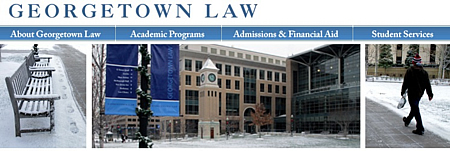Upsetting the Reset – The Technical Basis of Russian Concern Over NATO Missile Defense
The Obama administration is working with NATO to develop a missile defense shield to protect U.S. and European interests from ballistic missile attacks by Iran. Russian President Dmitry Medvedev has expressed strong concerns over this shield and has warned of a return to Cold War tensions, as well as possible withdrawal from international disarmament agreements like the New Strategic Arms Reduction Treaty (START).
On June 9, the NATO-Russia Council plans to meet with defense ministers to establish cooperation guidelines for the new European antiballistic missile system. The Federation of American Scientists (FAS) is releasing a new report that addresses concerns made by officials of the Russia Federation and provides recommendations for moving forward with a missile defense system..
Dr. Yousaf Butt, Scientific Consultant to FAS, and Dr. Theodore Postol, Professor of Science, Technology and National Security Policy in the Program in Science, Technology, and Society at the Massachusetts Institute of Technology, have published a technical assessment (PDF) of the Phased Adaptive Approach (PAA) missile defense system proposed by NATO and the United States and analyzed whether the Russian Federation has a legitimate concern over the proposed NATO-U.S. missile defense shield.
In practice the PAA will provide little, if any, protection leaving nuclear deterrence fundamentally intact. While the PAA would not significantly affect deterrence, it may be seen by cautious Russian planners to impose some attrition on Russian warheads. While midcourse missile defense would not alter the fundamental deterrence equation with respect to Iran or Russia, it may, in the Russian view, constitute an infringement upon the parity set down in New START.
New START Aggregate Numbers Released: First Round Slim Picking
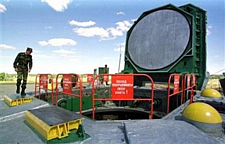 |
| You won’t be able to count SS-18s in the New START aggregate date. |
.
By Hans M. Kristensen
Russia and the United States have released the first Fact Sheet with aggregate numbers for the strategic offensive nuclear forces counted under the New START treaty.
It shows that Russia has already dropped below the New START ceiling of 1,550 accountable deployed warheads and the United States is close behind, seven years before the treaty is scheduled to enter into effect (it makes you wonder what all the ratification delay was about).
But compared with the extensive aggregate numbers that were released during the previous START treaty, the new Fact Sheet is slim picking: just six numbers.
Unless the two countries agree to release more information in the months ahead, this could mark a significant step back in nuclear transparency.
The Aggregate Numbers
The Fact Sheet includes six numbers for three categories of counted U.S. and Russian strategic nuclear arms under the treaty:
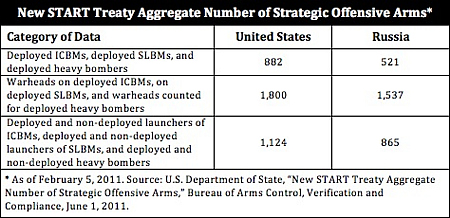
United States
The table lists 882 deployed delivery vehicles. Since we know this includes 450 ICBMs and 288 SLBMs, the number of bombers counted appears to be 144. Less than half of those (about 60 B-2 and B-52H) are actually assigned nuclear missions, the balance being “phantom” bombers (B-52H and B-1B) that have some equipment installed that makes them accountable under the treaty.
The 1,800 deployed warheads include approximately 500 on 450 ICBMs and approximately 1,152 on 288 SLBMs. The remaining 148 warheads constitute the remaining “fake” count of one weapon per deployed bomber. That means our estimate was only four warheads off (!).
If subtracting the 144 “fake” bomber weapons, the actual number of U.S. deployed strategic warheads on ICBMs and SLBMs is 1,656, only about 100 warheads from the New START ceiling. The actual number of bomber weapons present at the bases, we estimate, is 300 or less. They are not deployed on the bombers, so they are not counted by New START, but they were counted by the United States during the now-expired Moscow Treaty (SORT). So the real number of operationally available warheads may be around 1,950, which is what we estimated in March.
Another 2,290 non-deployed strategic warheads are in reserve and there are about 760 non-strategic warheads for a total stockpile of approximately 5,000 warheads. Another 3,500 or so warheads are awaiting dismantlement for a total inventory of roughly 8,500 warheads.
The total number of 1,124 deployed and non-deployed missiles and bombers shows that there are 242 non-deployed missiles and bombers. That number includes 48 SLBMs for two non-deployed SSBNs and additional test SLBMs, reserve Minuteman ICBMs and 50 retired Peacekeeper ICBMs, and heavy bombers in overhaul.
The United States has declassified considerable information in the past and hopefully will continue to do so in the future, so the limited aggregate numbers has fewer implications than in the case of Russia. But it would help to see a breakdown of bombers and non-deployed missiles.
Russian Federation
The effect of the limited aggregate numbers has a much more significant effect on the ability to understand the Russian nuclear posture. Most important is the absence of a breakdown of strategic delivery vehicles.
The number of deployed delivery vehicles is listed as 521. The final aggregate number from the expired START treaty was 630 as of July 1, 2009. Not surprisingly, a reduction because the SS-18, SS-19, SS-25 and SS-N-18 are being phased out. But the limited aggregate information makes it impossible to see which missiles have been reduced.
In our latest estimate we counted 534 deployed delivery vehicles, or 13 more than the New START data. The difference may reflect that some SLBMs on Delta IV SSBNs were not fully deployed and a slightly different composition of the ICBM force.
The Fact Sheet lists 1,537 deployed warheads, which actually translates into 1,461 warheads because 76 of them are “fake” bomber weapons. That means Russia has already met the warhead limit of New START – seven years before the treaty enters into effect.
Despite the uncertainty about the force structure, our latest estimate of Russian strategic nuclear warheads deployed on ICBMs and SLBMs was only 122 warheads off.
The aggregate deployed warhead number also more or less confirms long-held suspicion that Russia normally loads its missiles with their maximum capacity of warheads, in contrast to the United States practice of loading only a portion of the warheads.
That means that Russia only has comparatively few strategic warheads in reserve (essentially all bomber weapons). New START does not count such warheads, nor does it count 3,700-5,400 non-strategic warheads in storage or some 3,200 warheads awaiting dismantlement, for a total inventory of up to 11,000 warheads.
The total aggregate number for deployed and non-deployed delivery vehicles is listed as 865. That shows us that Russia has 344 non-deployed delivery vehicles, a considerable amount given the relatively limited size of their deployed force of 521 delivery vehicles. Since Russia has a limited number of bombers more or less exclusively committed to the nuclear mission, the non-deployed delivery vehicles mainly include retired ICBMs. It would be good to hear whether they will be destroyed or stored.
Additional releases
Each of the two parties to New START can decide under the treaty to release additional information to the public about their own nuclear postures. Given the limited information in the aggregate numbers Fact Sheet, it would be a huge disappoint if they don’t.
I understand from the U.S. government that it is planning to do so later this year, and it is important that Russia considers doing so as well.
Under the terms of the treaty the two parties may also agree to jointly release additional information.
Implications
At a first glance the aggregate numbers released by the United States and Russia under the New START treaty is a huge disappointment. It represents a step back in nuclear transparency compared with the standard set by the same two countries under the previous START treaty.
Earlier last month, Ambassador Linton Brooks, Ambassador Jack Matlock and Secretary William Perry joined FAS in calling on the United States and Russia to continue to meet this standard.
We have yet to receive a formal reply but the aggregate numbers Fact Sheet is a reply of sort.
It ought to be a natural that international nuclear transparency is increased with each new treaty, that previously unaccounted categories are brought under accounting, and that uncertainties are cleared up. Moreover, international nuclear transparency means transparency not just for the two parties to the treaty but for the international community as well.
The aggregate numbers Fact Sheet includes the total number of warheads actually deployed on ICBMs and SLBMs, an important improvement from the previous treaty. But the breakdown of number of delivery vehicles and deployment locations has moved into the black.
As mentioned above, the United States and Russia have the right under the treaty – individually or jointly – to release additional information about their nuclear force structures.
It is essential that they do so and continue to do so with each future aggregate numbers Fact Sheet release. Otherwise, the uncertainty about their forces could accumulate and undermine predictability and transparency for other nuclear powers. That, in turn, could make it harder to get those countries involved in nuclear arms control in the future.
This publication was made possible by a grant from Carnegie Corporation of New York and Ploughshares Fund. The statements made and views expressed are solely the responsibility of the author.
Letter Urges Release of New START Data
 |
| Ambassador Brooks, Secretary Perry and Ambassador Matlock join FAS in call for continuing nuclear transparency under New START treaty |
.By Hans M. Kristensen,
Three former U.S. officials have joined FAS in urging the United States and Russia to continue to declassify the same degree of information about their strategic nuclear forces under the New START treaty as they did during the now-expired START treaty.
The three former officials are: Linton Brooks, former chief U.S. START negotiator and administrator of the National Nuclear Security Administration, Jack Matlock, former U.S. ambassador to the Soviet Union and Special Assistant to President Ronald Reagan for national security affairs, and William Perry, former U.S. Secretary of Defense.
At issue is whether the United States and Russia will continue under the New START treaty to release to the public detailed lists – known as aggregate data – of their strategic nuclear forces with the same degree of transparency as they used to do under the now-expired START treaty. There has been concern that the two countries might reduce the information to only include numbers of delivery systems but withhold information about warhead numbers and locations.
In a joint letter, the three former officials joined FAS President Charles Ferguson and myself in urging the United States and Russia to “continue under the New START treaty the practice from the expired START treaty of releasing to the public aggregate numbers of delivery vehicles and warheads and locations.” This practice contributed greatly to international nuclear transparency, predictability, reassurance, and helped counter rumors and distrust, the letter concludes.
Both governments have stated their intention to seek to broaden the nuclear arms control process in the future to include other nuclear weapon states and the letter warns that achieving this will be a lot harder if the two largest nuclear weapon states were to decide to decrease transparency of their nuclear forces under New START.
“Any decrease in public release of information compared with START would be a step back.”
The letter was sent to Rose Gottemoeller, the U.S. Assistant Secretary of State for Arms Control, Verification and Compliance, and Sergey Kislyak, the Ambassador of the Russian Federation to the United States.
This publication was made possible by a grant from Carnegie Corporation of New York and Ploughshares Fund. The statements made and views expressed are solely the responsibility of the author.
New Article: Russian Nuclear Forces, 2011
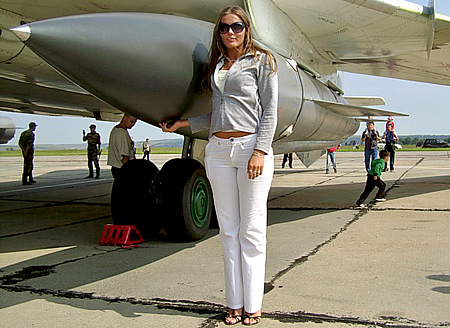 |
| Russia has 3,700-5,400 nonstrategic nuclear weapons, including the old dual-capable AS-4 Kitchen air-launched missile seen here under the wings of a Tu-22 Backfire bomber at an unknown airbase. All Russian nonstrategic warheads are in central storage. Image: web |
.
By Hans M. Kristensen
The latest Nuclear Notebook in the Bulletin of the Atomic Scientists with our updated estimate of Russian nuclear forces is now available via Sage Publications: http://bos.sagepub.com/content/67/3/67.full.pdf+html.
We estimate that Russia currently has nearly 2,430 strategic warheads assigned to operational strategic missiles and bombers, although most of the bomber weapons are probably in central storage. Another 3,700-5,400 nonstrategic warheads are in central storage, of which an estimated 2,080 can be delivered by nonstrategic aircraft, naval vessels and short-range missiles. Another 3,000 warheads are thought to be awaiting dismantlement, for a total inventory of some 11,000 nuclear warheads.
See also: US Nuclear Forces, 2011 | US Tactical Nuclear Weapons in Europe, 2011 | Nonstrategic Nuclear Weapons After the Presidential Nuclear Initiatives (Brief 2011)
This publication was made possible by a grant from Carnegie Corporation of New York and Ploughshares Fund. The statements made and views expressed are solely the responsibility of the author.
10 NATO Countries Want More Transparency for Non-Strategic Nuclear Weapons
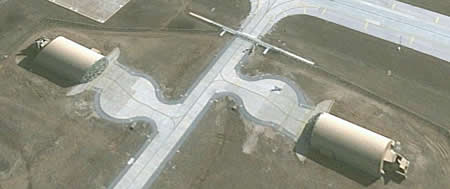 |
| Ten NATO countries recommend increasing transparency of non-strategic nuclear weapons, including numbers and locations at military facilities such as Incirlik Air Base in Turkey. Neither NATO nor Russia currently disclose such information. |
.
By Hans M. Kristensen
Four NATO countries supported by six others have proposed a series of steps that NATO and Russia should take to increase transparency of U.S. and Russian non-strategic nuclear weapons.
The steps are included in a so-called “non-paper” that Germany, the Netherlands, Norway and Poland jointly submitted at the NATO Foreign Affairs Minister meeting in Berlin on 14 April.
Six other NATO allies – Belgium, the Czech Republic, Hungary, Iceland, Luxemburg and Slovenia – also supported the paper.
The four-plus-six group recommend that NATO and Russia:
- Use the NATO-Russia Council (NRC) as the primary framework for transparency and confidence-building efforts concerning tactical nuclear weapons in Europe.
- Exchange information about U.S. and Russian tactical nuclear weapons, including numbers, locations, operational status and command arrangements, as well as level of warhead storage security.
- Agree on a standard reporting formula for tactical nuclear weapons inventories.
- Consider voluntary notifications of movement of tactical nuclear weapons.
- Exchange visits by military officials [presumably to storage locations].
- Exchange conditions and requirements for gradual reductions of tactical nuclear weapons in Europe, including clarifying the number of weapons that have been eliminated and/or stored as a result of the 1991-1992 Presidential Nuclear Initiatives (PNIs).
- Hold a NRC seminar on tactical nuclear weapons in the first quarter of 2012 in Poland.
According to estimates developed by Robert Norris and myself, the United States currently has an inventory of approximately 760 non-strategic nuclear weapons, of which 150-200 bombs are deployed in five European countries. Russia (updated estimate forthcoming soon, previous estimate here) has larger inventory of 3,700-5,400 nonstrategic weapons in central storage, of which an estimated 2,000 are deliverable by nuclear-capable forces.
The proposal comes as the first phase of NATO’s new Defense and Deterrence Posture Review (DDPR) has begun preparation of four so-called scoping papers on 1) the threat facing NATO, 2) the alliance’s strategic mission, 3) the appropriate mix of military forces, and 4) the alliance’s arms control and disarmament policy. The four-plus-six initiative seeks to provide input to the DDPR as well as future work of NATO’s new Weapons of Mass Destruction (WMD) Control and Disarmament Committee. The results of the DDPR are scheduled for approval by the alliance at the summit in March 2012.
Five of the 10 countries supporting the new initiative also were behind an initiative in February 2010 that urged the alliance to include its nuclear policy on the agenda for the NATO meeting in Tallinn in April 2010. The non-paper builds on a previous Polish-Norwegian initiative from April 2010 that is not described.
The Strategic Concept adopted by NATO in November 2010 removed much of the language that previously had identified U.S. non-strategic nuclear weapons in Europe as the trans-Atlantic “glue” in the alliance. Unfortunately, after unilaterally reducing the U.S. weapons in Europe by more than half between 2000 and 2010 and insisting that the deployment was not linked to Russia, NATO reinstated Russia as an official link by concluding in the Strategic Concept that “any” reductions in the U.S. deployment must take into account the disparity with Russian non-strategic nuclear weapons.
The four-plus-six paper does not explicitly call for new cuts and explicitly rejects unilateral reductions. However, it states that transparency and confidence building are “crucial to paving the way for concrete reductions.” To that end the paper is in tune with statements recently made by Gary Samore, Special Assistant to the President and White House Coordinator for Arms Control and Weapons of Mass Destruction, Proliferation, and Terrorism, and by Rose Gottemoeller, Assistant Secretary of State for the Bureau of Arms Control, Verification and Compliance.
I’m an avid supporter of increasing transparency, but given the success of the unilateral Presidential Nuclear Initiatives (PNIs) of 1991-1992 in jumpstarting reductions in non-strategic nuclear weapons without verification, I’m a little concerned about how ready some are to reject unilateral cuts. After all, the United States and NATO have just approved one: retirement of the nuclear Tomahawk land-attack missile (TLAM/N). Rather, transparency, unilateral cuts, and negotiated reductions should all be embraced as tools to move the process forward of reducing the number and role of nuclear weapons.
See: NATO Non-Paper on Non-Strategic Nuclear Weapons
This publication was made possible by a grant from Carnegie Corporation of New York and Ploughshares Fund. The statements made and views expressed are solely the responsibility of the author.
New START Data Exchange: Will it Increase or Decrease International Nuclear Transparency?
 |
| U.S. officials say that aggregate numbers of the New START treaty will be made publicly available but that these may be very general numbers and a decision still has to be made. For a copy of the final START aggregate numbers, click here. |
.
By Hans M. Kristensen
The first data exchange of the New START treaty between the United States and Russia has taken place, according to a report by RIA Novosti.
This is the first of more than 20 such data exchanges planned under the treaty for the next 10 years where Russia and the United States twice a year will send each other a list showing how many long-range ballistic missiles and heavy bombers they have and how many nuclear weapons they carry.
But while the exchanges will increase U.S-Russia nuclear transparency, the rest of the world may be facing a future with less information about U.S. and Russian strategic nuclear forces than in the past.
“All exchanges are classified and will not be subject to release,” a U.S. official told me. “There may be some information on very general numbers under the Treaty that could be made public, but that is still to be determined, and will not occur for a least six months if it occurs at all.”
Previous Nuclear Transparency
During the previous START treaty regime between 1994 and 2009, the two countries also exchanged data. That data was classified but the two sides released so-called aggregate numbers biannually to the public (the final START release is here]. Rose Gottemoeller, the U.S. Assistant Secretary for the Bureau of Arms Control, Verification and Compliance, assured early on that “data on the aggregate number of warheads each Party deploys on ICBMs and SLBMs will be exchanged and made publicly available” for New START as well. (Emphasis added)
Hopefully that will happen, but the aggregate numbers release was based on a much larger document – the Memorandum of Understanding (MOU) – exchanged between the two countries twice a year. The unclassified MOU was not published because (I was told) of Russian objections, but the United States would – upon request – release the MOU, which provided much more detailed data for each nuclear weapon and facility.
| START July 2009 Memorandum of Understanding |
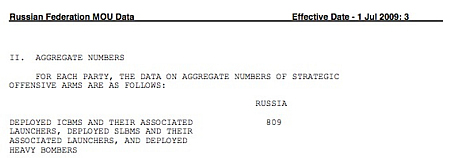 |
| The first START treaty provided the public with detailed overviews of U.S. and Russian strategic nuclear forces. Will New START do so as well or decrease international nuclear transparency? To down copy of the final START MOU, click here. |
.
The MOU provided important information for the international community to monitor the development of U.S. and Russian long-range nuclear forces. But the official statements made so far suggest that such detailed information might not be released under New START.
Implications and Recommendations
The New START treaty is widely seen as a first step in a process that seeks to involve other nuclear weapon states in future nuclear arms control negotiations. As such, it is important that the United States and Russia continue to make detailed information on the status of their nuclear forces available to the international community.
At the very least, this should include the aggregate numbers – including breakdown by individual nuclear weapon systems. But it should also continue the practice of releasing the full unclassified MOUs to increase international transparency and predictability in nuclear forces. Doing anything else would be a step back that could create mistrust and undercut a broadening of the nuclear arms control progress to other nuclear weapon states.
Each new step in the arms control process must increase transparency, not reduce it.
This publication was made possible by a grant from Carnegie Corporation of New York and Ploughshares Fund. The statements made and views expressed are solely the responsibility of the author.
Talk at Georgetown U Event on Tac Nuke Treaty
By Hans M. Kristensen
The Center on National Security and the Law and the Federal Legislation and Administrative Clinic co-hosted an event at Georgetown University Law Center on Tuesday, March 1st: Next Steps after New START: A Treaty on Tactical Nuclear Weapons.
The event included a keynote speech by Edward Warner, the Senior Advisor to the under Secretary of Defense for Policy.
I gave a briefing on the status of US and Russian nonstrategic nuclear weapons. Other panelists included Michael May, former director of Lawrence Livermore National Laboratory and now at Stanford University, Paul Dean from the Department of State, Madelyn Creedon with the Senate Armed Services Committee, and Tim Morrison from the office of Senator Jon Kyl. Dakota Rudesill from the Law Center moderated.
This publication was made possible by a grant from Carnegie Corporation of New York and Ploughshares Fund. The statements made and views expressed are solely the responsibility of the author.
Air Force Magazine Prints Nuke Chart
 |
By Hans M. Kristensen
The January 2011 issue of Air Force Magazine has a nice spread on the Chart Page where they reproduce a chart I produced of U.S. and Russian nuclear warhead inventories.
The chart is the product of the research and public education I do about the status of nuclear forces in collaboration with the nuclear program over at the Natural Resources Defense Council.
This chart was initially used in a de-alerting briefing at the United Nations last October.
This publication was made possible by a grant from Carnegie Corporation of New York and Ploughshares Fund. The statements made and views expressed are solely the responsibility of the author.
New START: It’s in the Bag!
 |
| The New START treaty is in the bag, approved by the US Congress and Russian Duma. |
.
By Hans M. Kristensen
The upper house of the Russian Parliament (Duma) earlier today approved the New START treaty signed by presidents Medvedev and Obama in Prague on April 8, 2010. This follows approval of the treaty by the U.S. Senate in December despite opposition from hard-liners.
The Russian approval was followed by optimistic statements by Mikhail Margelov, the chairman of the international affairs committee, who declared: “The arms race is a thing of the past. The disarmament race is taking its place.”
What Now?
Now that the treaty has been ratified by both countries, the next step will be an exchange of Instruments of Ratification, at which point the treaty formally enters into effect. When that happens, the Moscow Treaty from 2002 will expire. Within 45 days after entry into force, the two countries will have an initial exchange of data (an initial exchange of site diagrams occurred 45 days after the treaty was signed on April 8, 2010), and photographs of the strategic offensive arms covered by the treaty will be exchanged. After that the inspectors go to work.
No it Doesn’t
But the treaty does not, as the New York Times report mistakenly states, “require the United States and Russia to reduce their nuclear arsenals…to 1,550 warheads each, from between 1,700 and 2,200 now.” This is a misreporting that is frequent in the news media (see also RIA Novosti). In fact, the treaty does not place any limits on the total size of their nuclear arsenals — in fact, it doesn’t require destruction of a single nuclear warhead. Rather, New START reduces the limit for how many of their strategic warheads the two countries may deploy on long-range delivery vehicles at any given time. Both countries may – and do – have thousands of other nuclear warheads that are not deployed or not counted.
Of the estimated 5,000 and 8,000 US and Russian, respectively, nuclear warheads in their military stockpiles, New START affects how 1,550 can be deployed on each side. How to deal with the remaining thousands of non-deployed and nonstrategic nuclear warheads is the focus of the next round of US-Russian nuclear arms control efforts. In addition, both countries have thousands of additional retired but intact warheads awaiting dismantlement, for total estimated inventories of 8,500 US and 11,000 Russian warheads.
New START is in the bag but a lot of work remains to be done.
This publication was made possible by a grant from Carnegie Corporation of New York and Ploughshares Fund. The statements made and views expressed are solely the responsibility of the author.
Senate Approval of New START Moves Nuclear Arms Control Forward
By Hans M. Kristensen
The Federation of American Scientists today applauded the Senate’s ratification of the New START (Strategic Arms Reduction Treaty) between the United States and Russia.
The Senate voted 71 to 26 in favor of ratification of the treaty.
The approval of the treaty is a victory for common sense and an impressive achievement for the Obama administration in overcoming stubborn opposition from Cold Warriors to modest nuclear arms reductions.
New START does not require destruction of a single nuclear warhead, but it reduces the limit for how many of them can be deployed on long-range ballistic missiles and heavy bombers.
The United States and Russia possess more than 90 percent of the world’s nuclear weapons and will continue to do so when the treaty limit is reached seven years from now.
During the past year and in an effort to ensure Congressional support for New START, the administration has committed to significant increases in spending on modernizing nuclear weapons and the production complex over the next decade: well over $100 billion for modernization of missiles and bombers, and more than $85 billion for modernizing warheads and production facilities.
This modernization will have to be balanced against the other important goal of U.S. nuclear policy: securing international support for strengthening non-proliferation of nuclear weapons and materials. Demonstrating clear intensions to reducing the number and role of nuclear weapons will be essential to winning support for this agenda.
Despite its limitations, the approval of the New START treaty brings U.S-Russian strategic relations back on track, reestablishes a vital on-site inspection regime, and potentially opens the way for negotiations on additional reductions in the future.
Those negotiations must establish limits on and verification of U.S. and Russian non-deployed and non-strategic nuclear weapons, and prepare the ground for broadening nuclear arms control to the other nuclear weapons states.
This publication was made possible by a grant from Carnegie Corporation of New York and Ploughshares Fund. The statements made and views expressed are solely the responsibility of the author.
Tac Nuke Numbers Confirmed?
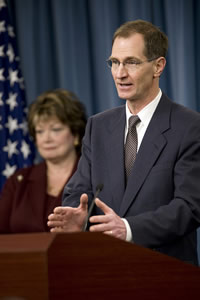 |
| PDUSPD Jim Miller appears to confirm FAS/NRDC estimates for NATO and Russia tactical nuclear weapons. |
By Hans M. Kristensen
A Wikileaks document briefly posted by The Guardian Monday appears to give an official number for the U.S. nuclear weapons deployed in Europe: 180.
The number appears in a leaked cable written by U.S. NATO Ambassador Ivo Dalder in September 2009, describing an earlier Nuclear Posture Review briefing U.S. Principal Deputy Under Secretary of Defense for Policy Jim Miller gave to NATO in July 2009.
Miller’s number is smack in the middle of the estimate Stan Norris and I have developed. I recently published a snapshot here (previous NATO posts are here), and a more detailed overview will appear in the January Nuclear Notebook in the Bulletin of the Atomic Scientists.
Miller also stated that Russia had 3,000-5,000 plus tactical nuclear weapons. That also fits our estimate of approximately 5,300 weapons, previously published here and here.
Whether Miller was providing certified U.S. intelligence numbers or simply referenced good-enough nonofficial public estimates is less clear. But his use of a specific number (180) for Europe rather than a range suggests that it might an official number.
It’s Up, It’s Down
The cable first appeared in a Guardian story that was posted on the news paper’s web site Monday with the cable. The posting was a mistake and the story was quickly taken down (the editors decided that the initial story didn’t contain significant news; it may get back up), but not before bloggers had picked it up. The first reposting of the document appeared on Hedgehogs.
I’ve since tried to find the cable on the Wikileaks web site, but it doesn’t seem to be there. If anyone knows the original link, please let me know.
Implications
I’ll publish on U.S. and Russian tactical nuclear weapons later in 2011, but the importance of the number 180 (if correct) is that it confirms that the United States during the past decade has been unilaterally reducing the deployment in Europe without demanding reductions in Russian tactical nuclear weapons. Miller correctly points to “the difficulty of bringing Russia to the bargaining table with 180 NATO sub-strategic warheads on offer against the estimated 3-5 thousand Russian warheads in that category.”
As I recently pointed out, there is important progress in NATO’s new Strategic Concept, but some language is unfortunate because it appears to reinstitute Russian as an adversary by demanding that any addition reductions in U.S. nuclear weapons in Europe must take into consideration Russia’s larger inventory of tactical nuclear weapons.
Some Baltic NATO countries have called for new contingency planning against Russia, but Ambassador Dalder pointed to the dilemma this creates for NATO’s long-held position that Russia is not an enemy.
I couldn’t agree more. NATO and the United States should certainly try to convince Russia to reduce its tactical nuclear weapons, but the previous unilateral U.S. reductions in Europe demonstrate that NATO can and should decide the future of the remaining U.S. nuclear weapons in Europe independent of the number of Russian tactical nuclear weapons.
This publication was made possible by a grant from Carnegie Corporation of New York and Ploughshares Fund. The statements made and views expressed are solely the responsibility of the author.
New START Ratification: Seeing the Bigger Picture
 |
| Morton Halperin speaks at CSIS |
By Hans M. Kristensen
Kevin Kallmyer at CSIS has an interesting recap of a recent debate between Paula DeSutter and Mort Halperin about the New START Treaty.
Ratification of the treaty is held up in Congress by a handful of Senators who (mis)use questions about, among other issues, verification to extort billions of dollars to pet nuclear modernization projects at the expense of greater U.S. interests.
During the CSIS debate, Mort Halperin provided an enlightening anecdote about how to judge whether ratification of the treaty is in the U.S. interest. It cuts to the heart of what is important and deserves a repost here:
How do you decide whether a Treaty is in the American interest in relation to verification? The question cannot be are we sure that we will have 100% confidence that we would detect the first instance of Russian cheating. The question has to take into account the limits of the Treaty, and some degree of Russian cheating, is it in our interest to have the limit in the treaty, as opposed to not constraining the Russian forces. Our notion of what is acceptable verification goes back to the Reagan administration, it actually goes back before that…because the last time the Joint Chiefs of Staff held the view that a limit was not acceptable unless it could be 100% verifiable was in 1968. At that point, the Administration was planning to put forward a proposal to the Soviet Union to ban the further production of any ballistic missiles or submarines. The Joint Chief’s position then was to we can only include things in the agreement if we could be absolutely certain there will be no Russian cheating. A navy officer came to me one day and said, “Well, we cannot include submarines in the agreement.”
I said, “Why is that?”
He said, “Because the CIA has just come out with its estimate that said the Russians could cheat on an agreement that bans Russia from building any more ballistic missile submarines.”
And I said, “What does it say?”
He said, “It says the Russians could build as many as 3 submarines and we wouldn’t detect it, and only if they build a fourth submarine could we have very high confidence of detection.”
And I said, “How many submarines doe we have now?”
He said, “41.”I said, “How many submarines do we plan to have 10 years from now.”
He said “41.”
I said, “How many submarines do the Russians have now?”
He said, “I think one.”
I said, “How many do we think they will have in 10 years from now.”
He said, “50.”
I said, “So, you prefer a world where we do not limit this and the Russians have 50 submarines and we have 41, to a world where we have 41, and the Russians have [4] until we can be sure we detect the [5th] submarine.”
And he said, “That’s right, the principle is that you do not include something in an agreement that cannot be verified.”
I looked at him and said, “Well, I think I’m going to win this fight…and I did.”
And the Joint Chiefs changed their position then, to what is clearly the correct position. You ask yourself about each limit, including the warhead limit in this treaty; is it in our interest to have this limit, recognizing that there obviously could be some amount of Russian cheating. The question is how much Russian cheating can there be before we detect it, and the question is what is the strategic significance of that cheating. We have seen no such analysis, because no such analysis that could be presented would be the slightest bit persuasive. The fact is that with the margin of deterrence we have to deter a Russian attack, that the margins of cheating the Russians can do is simply insignificant to the security to the United States.
Check out the full debate at the CSIS web site.
This publication was made possible by a grant from Carnegie Corporation of New York and Ploughshares Fund. The statements made and views expressed are solely the responsibility of the author.
